Thermally Activated Crack Growth and Fracture Toughness Evaluation of Pipeline Steels Using Acoustic Emission
Abstract
1. Introduction
2. Materials and Methods
2.1. Fracture Mechanics and Thermally Activated Crack Growth
2.2. Multilevel Acoustic Emission Model
2.3. Experimental Data
| Material | ||||||||||||
|---|---|---|---|---|---|---|---|---|---|---|---|---|
| AISI 1080 [60] | 0.0039 | 0.0031 | 1.26 × 10−23 | 96,562 | 155 | 202 | 439 | 948 | 205,000 | 46.0 | 45.5 | 5.38× 10−21 |
| AISI 316LN (base metal) [18] | 0.0006 | 0.0010 | 3.96× 10−24 | 101,130 | 102 | 1046 | 1318 | 1028 | 205,000 | 85.4 | 44.1 | 1.47× 10−21 |
| AISI 316LN (weld metal) [18] | 0.0012 | 0.0035 | 1.43× 10−23 | 105,461 | 75 | 880 | 1091 | 506 | 205,000 | 81.0 | 76.1 | 4.86× 10−21 |
| AISI 316LN (base metal) [79] | 0.0009 | 0.0014 | 5.84× 10−24 | 101,024 | 255 | 916 | 1190 | 1023 | 205,000 | 144.1 | 50.3 | 1.52× 10−21 |
| AISI 316LN (weld metal) [79] | 0.0012 | 0.0020 | 7.95× 10−24 | 100,808 | 409 | 766 | 986 | 909 | 205,000 | 111.5 | 58.7 | 6.70× 10−22 |
| AISI D2 (E3 sample) [61] | 0.0163 | 0.0040 | 1.63× 10−23 | 100,767 | 273 | 346 | 1124 | 1090 | 200,000 | 50.2 | 81.5 | 1.45× 10−20 |
| AISI D2 (C2 sample) [61] | 0.0173 | 0.0035 | 1.42× 10−23 | 101,112 | 270 | 309 | 1341 | 1262 | 200,000 | 36.2 | 83.3 | 8.72× 10−21 |
| G20Mn5QT (1 sample) [80] | 0.0172 | 0.0343 | 1.39× 10−22 | 134,431 | 294 | 434 | 537 | 530 | 205,752 | 259.8 | 167 | 2.26× 10−21 |
| G20Mn5QT (2 sample) [80] | 0.0218 | 0.0666 | 2.69× 10−22 | 178,741 | 274 | 405 | 553 | 270 | 205,752 | 260.1 | 236 | 4.53× 10−21 |
| G20Mn5QT (3 sample) [80] | 0.0188 | 0.0326 | 1.32× 10−22 | 133,325 | 208 | 413 | 553 | 546 | 205,752 | 279.2 | 165 | 1.92× 10−21 |
3. Results
3.1. Kinetic Parameters of Crack Growth Rate
3.2. AE Fracture Toughness Tests
4. Discussion
5. Conclusions
Author Contributions
Funding
Data Availability Statement
Conflicts of Interest
Abbreviations
| Symbol | Meaning |
| Stress intensity factor (SIF) | |
| Stress intensity coefficient at the start of crack growth | |
| Fracture toughness | |
| Driving force of crack expansion per unit length of its profile | |
| Effective force of crack expansion | |
| Young’s modulus | |
| Applied stress | |
| Rate of stress growth | |
| Change in the free energy of a body containing a crack | |
| Change in elastic energy | |
| Change in surface energy | |
| Free energy of a body without a crack | |
| Total activation energy (energy equal to overcome the energy barrier at crack tip) | |
| Specific surface energy | |
| Non-activation crack growth rate | |
| Activation energy of destruction (kinetic nature of fracture) | |
| Structural parameter included in equation of time dependent fracture (kinetic nature of fracture) | |
| Fracture surface area | |
| Area of the activation zone | |
| Thermodynamic activation region | |
| Coefficient proportional to the activation volume and activation area | |
| Fraction of work that is spent on breaking atomic bonds | |
| Atomic size of the activation area | |
| Internal energy | |
| Entropy of a system consisting of a solid body with a crack | |
| Helmholtz energy | |
| Body volume | |
| Length of the elementary step of the crack during overcoming the barrier | |
| Initial concentration of structural elements (potential number of microcracks) | |
| Critical value of the damage parameter before the beginning of unstable crack growth | |
| Pre-exponential factor in the phenomenological equations of crack growth rate | |
| Pressure | |
| Activation energy of crack growth (kinetic nature of fracture) | |
| Structural parameter included in the crack growth rate equation (kinetic nature of fracture) | |
| Acoustic emission parameters of damage accumulation during crack growth |
References
- Rozumek, D.; Macha, E. A survey of failure criteria and parameters in mixed-mode fatigue crack growth. Mater. Sci. 2009, 45, 190–210. [Google Scholar] [CrossRef]
- Karyakina, E.; Shammazov, I.; Voronov, V.; Shalygin, A. The Simulation of Ultra-High Molecular Weight Polyethylene Cryogenic Pipeline Stress-Strain State. Mater. Sci. Forum 2021, 1031, 132–140. [Google Scholar] [CrossRef]
- Dzhemilev, E.; Shammazov, I.; Sidorkin, D.; Mastobaev, B.; Gumerov, A.; Arctic, S.C. Developing technology and device for the main pipelines repair with cutting out their defective sections. Neft. Khozyaystvo Oil Ind. 2022, 10, 78–82. [Google Scholar] [CrossRef]
- Nasonov, M.; Lykov, Y.; Trong, D.D. The study of the resource and durability of metal structures of excavators after the expiration of the service life. Ugol 2020, 2, 13–17. [Google Scholar] [CrossRef]
- Belyakov, N.; Smirnova, O.; Alekseev, A.; Tan, H. Numerical Simulation of the Mechanical Behavior of Fiber-Reinforced Cement Composites Subjected Dynamic Loading. Appl. Sci. 2021, 11, 1112. [Google Scholar] [CrossRef]
- Korobov, G.Y.; Nguyen Van, T.; Parfenov, D.V. Mechanisms of the formationof asphalt-resin and paraffin deposits and factors influencing their intensity. Bulletin of the Tomsk Polytechnic University. Geo Assets Eng. 2023, 334, 103–116. [Google Scholar] [CrossRef]
- Karasev, M.A.; Buslova, M.A.; Vilner, M.A.; Nguyen, T.T. Method for predicting the stress-strain state of the vertical shaft lining at the drift landing section in saliferous rocks. J. Min. Inst. 2019, 240, 628–637. [Google Scholar] [CrossRef]
- Bolobov, V.I.; Latipov, I.U.; Popov, G.G.; Buslaev, G.V.; Martynenko, Y.V. Estimation of the Influence of Compressed Hydrogen on the Mechanical Properties of Pipeline Steels. Energies 2021, 14, 6085. [Google Scholar] [CrossRef]
- Zemenkova, M.Y.; Chizhevskaya, E.L.; Zemenkov, Y.D. Intelligent monitoring of the condition of hydrocarbon pipeline transport facilities using neural network technologies. J. Min. Inst. 2022, 258, 933–944. [Google Scholar] [CrossRef]
- Shammazov, I.A.; Sidorkin, D.I.; Batyrov, A.M. Ensuring the stability of above-ground main pipelines in areas of continuous distribution of permafrost. Eng. Georesources. 2022, 333, 200–207. [Google Scholar] [CrossRef]
- Said, G.; Aytekin, H. A new method for determining the fracture toughness of main pipeline steels. Fatigue Fract. Eng. Mater. Struct. 2013, 36, 640–649. [Google Scholar] [CrossRef]
- Li, C.-J. Effects of temperature and loading rate on fracture toughness of structural steels. Mater. Des. 2000, 21, 27–30. [Google Scholar] [CrossRef]
- Kotoul, M.; Bílek, Z. Acoustic emission during deformation and crack loading in structural steels. Int. J. Press. Vessel. Pip. 1990, 44, 291–307. [Google Scholar] [CrossRef]
- Baek, J.-H.; Kim, C.-M.; Kim, W.-S.; Kho, Y.-T. Fatigue crack growth and fracture toughness properties of 304 stainless steel pipe for LNG transmission. Met. Mater. Int. 2001, 7, 579–585. [Google Scholar] [CrossRef]
- Zárate, B.A.; Caicedo, J.M.; Yu, J.; Ziehl, P. Deterministic and probabilistic fatigue prognosis of cracked specimens using acoustic emissions. J. Constr. Steel Res. 2012, 76, 68–74. [Google Scholar] [CrossRef]
- Han, Z.; Luo, H.; Sun, C.; Li, J.; Papaelias, M.; Davis, C. Acoustic emission study of fatigue crack propagation in extruded AZ31 magnesium alloy. Mater. Sci. Eng. A 2014, 597, 270–278. [Google Scholar] [CrossRef]
- Erdogan, F. Stress Intensity Factors. Trans. ASME 1983, 50, 992–1002. [Google Scholar] [CrossRef]
- Chai, M.; Duan, Q.; Hou, X.; Zhang, Z.; Li, L. Fracture Toughness Evaluation of 316LN Stainless Steel and Weld Using Acoustic Emission Technique. ISIJ Int. 2016, 56, 875–882. [Google Scholar] [CrossRef]
- Nemati, N.; Metrovich, B.; Nanni, A. Acoustic Emission Assessment of Fatigue Crack Growth from a Transverse Weld Toe. J. Mater. Civ. Eng. 2016, 28, 83. [Google Scholar] [CrossRef]
- Zhang, Z.; Yang, G.; Hu, K. Prediction of Fatigue Crack Growth in Gas Turbine Engine Blades Using Acoustic Emission. Sensors 2018, 18, 1321. [Google Scholar] [CrossRef]
- Chai, M.; Zhang, J.; Zhang, Z.; Duan, Q.; Cheng, G. Acoustic emission studies for characterization of fatigue crack growth in 316LN stainless steel and welds. Appl. Acoust. 2017, 126, 101–113. [Google Scholar] [CrossRef]
- Baram, J.; Rosen, M. Fatigue life prediction by distribution analysis of acoustic emission signals. Mater. Sci. Eng. 1979, 41, 25–30. [Google Scholar] [CrossRef]
- Yu, J.; Ziehl, P. Stable and unstable fatigue prediction for A572 structural steel using acoustic emission. J. Constr. Steel Res. 2012, 77, 173–179. [Google Scholar] [CrossRef]
- Ritchie, R.O.; Knott, J.F.; Rice, J.R. On the relationship between critical tensile stress and fracture toughness in mild steel. J. Mech. Phys. Solids 1973, 21, 395–410. [Google Scholar] [CrossRef]
- Ciliberto, S.; Deschanel, S.; Guarino, A.; Santucci, S.; Scorretti, R.; Vanel, L. Failure time, critical behaviour and activation processes in crack formation. In Proceedings of the 11th International Conference on Fracture, Turin, Italy, 20–25 March 2005; pp. 1–6. [Google Scholar] [CrossRef]
- Cherepanov, G.P. Fracture mechanics and the kinetic theory of strength. Strength Mater. 1989, 21, 1431–1438. [Google Scholar] [CrossRef]
- Regel, V.R.; Leksovskii, A.M.; Sakiev, S.N. The kinetics of the thermofluctuation-Induced micro- and macrocrack growth in plastic metals. Int. J. Fract. 1975, 11, 841–850. [Google Scholar] [CrossRef]
- Bertenev, G.M. Kriterii Griffita i termofluktuatsionnaya teoriya razrusheniya polimerov. Vysokomol. Soedin. 1988, 30, 787–791. [Google Scholar]
- Irwin, G.R.; Paris, P.C. Fundamental Aspects of Crack Growth and Fracture. Engineering Fundamentals and Environmental Effects; Academic Press: New York, NY, USA, 1971; pp. 1–46. [Google Scholar]
- Krausz, A.S.; Krausz, K. Fracture Kinetics of Crack Growth; Springer Science & Business Media: Berlin/Heidelberg, Germany, 1988; ISBN 978-94-010-7116-1. [Google Scholar]
- Schoeck, G. Thermally activated crack-propagation in brittle materials. Int. J. Fract. 1990, 44, 1–14. [Google Scholar] [CrossRef]
- Petrov, V.A. K dilatonnoi modeli termofluktuatsionnogo zarozhdeniya treshchiny. Dokl. AN SSSR 1988, 301, 1107–1110. [Google Scholar]
- Atkins, A.G.; Lee, C.S.; Caddell, R.M. Time-temperature dependent fracture toughness of PMMA: Part 1. Journal of materials science. 1975, 10, 1381–1393. [Google Scholar] [CrossRef]
- Atkins, A.G.; Lee, C.S.; Caddell, R.M. Time-temperature dependent fracture toughness of PMMA: Part 2. J. Mater. Sci. 1975, 10, 1394–1404. [Google Scholar] [CrossRef]
- Brenner, S.S. Mechanical Behavior of Sapphire Whiskers at Elevated Temperatures. J. Appl. Phys. 1962, 33, 33–39. [Google Scholar] [CrossRef]
- Hsieh, C.; Thomson, R. Lattice theory of fracture and crack creep. J. Appl. Phys. 1973, 44, 2051–2063. [Google Scholar] [CrossRef]
- Mai, Y.W. Temperature and rate dependent fracture in glass-filled polystyrene. Polym. Eng. Sci. 1976, 16, 400–405. [Google Scholar] [CrossRef]
- Pisarenko, G.S.; Krasowsky, A.J.; Vainshtock, V.A. The combined micro- and macro-fracture mechanics approach to engineering problems of strength. Eng. Fract. Mech. 1987, 28, 539–554. [Google Scholar] [CrossRef]
- Pollet, J.C.; Burns, S.J. Thermally activated crack propagation? Theory. Int. J. Fract. 1977, 13, 667–679. [Google Scholar] [CrossRef]
- Bezyazychnyi, V.F.; Szczerek, M.; Pervov, M.L.; Timofeev, M.V.; Prokofiev, M.A. The study of the effect of temperature on the ability of metals to accumulate energy during their plastic deformation. J. Min. Inst. 2019, 235, 55–59. [Google Scholar] [CrossRef]
- Santucci, S.; Vanel, L.; Guarino, A.; Scorretti, R.; Ciliberto, S. Thermal activation of rupture and slow crack growth in a model of homogeneous brittle materials. EPL Europhys. Lett. 2003, 62, 320–326. [Google Scholar] [CrossRef]
- Rice, J.R.; Beltz, G.E. The activation energy for dislocation nucleation at a crack. J. Mech. Phys. Solids 1994, 42, 333–360. [Google Scholar] [CrossRef]
- Hartmaier, A.; Gumbsch, P. Thermal activation of crack-tip plasticity: The brittle or ductile response of a stationary crack loaded to failure. Phys. Rev. B 2005, 71, 24108. [Google Scholar] [CrossRef]
- Cherepanov, G.P.; Richter, A.; Verijenko, V.E.; Adali, S.; Sutyrin, V. Dislocation generation and crack growth under monotonic loading. J. Appl. Phys. 1995, 78, 6249–6264. [Google Scholar] [CrossRef]
- Regel, V.; Slutsker, A.; Tomashevskii, É.E. The kinetic nature of the strength of solids. Uspekhi Fizicheskih Nauk. 1972, 106, 193–228. [Google Scholar] [CrossRef]
- Regel, V.R. Kinetic theory of strength as a scientific basis for predicting the lifetime of polymers under load. Polym. Mech. 1973, 7, 82–93. [Google Scholar] [CrossRef]
- Wiederhorn, S.M.; Fuller, E.R.; Thomson, R. Micromechanisms of crack growth in ceramics and glasses in corrosive environments. Met. Sci. 1980, 14, 450–458. [Google Scholar] [CrossRef]
- Wiederhorn, S.M.; Johnson, H.; Diness, A.M. Fracture of Glass in Vacuum. J. Am. Ceram. Soc. 1974, 57, 336–341. [Google Scholar] [CrossRef]
- Kawasaki, T.; Nakanishi, S.; Sawaki, Y.; Hatanaka, K.; Yokobori, T. Fracture toughness and fatigue crack propagation in high strength steel from room temperature to −180 °C. Eng. Fract. Mech. 1975, 7, 465–472. [Google Scholar] [CrossRef]
- Zhang, S.; Zhu, T.; Belytschko, T. Atomistic and multiscale analyses of brittle fracture in crystal lattices. Phys. Rev. B 2007, 76, 94114. [Google Scholar] [CrossRef]
- Kozinkina, A.I.; Kozinkina, E.A. Opredelenie kontsentratsii deformatsionnykh defektov. Prikl. Mekhanika Tekhnicheskaya Fiz. 2010, 51, 164–170. [Google Scholar]
- Novikov, E.A.; National University of Science and Technology «MISiS»; Shkuratnik, V.I.; Zaytsev, M.G. Manifestations of Acoustic Emission in Frozen Soils with Simultaneous Influence of Variable Mechanical and Thermal Effects on Them. J. Min. Inst. 2019, 238, 383–391. [Google Scholar] [CrossRef]
- Clark, G.; Corderoy, D.J.H.; Ringshall, N.W.; Knott, J.F. Acoustic emissions associated with fracture processes in structural steels. Met. Sci. 1981, 15, 481–491. [Google Scholar] [CrossRef]
- Šofer, M.; Šofer, P.; Pagáč, M.; Volodarskaja, A.; Babiuch, M.; Gruň, F. Acoustic Emission Signal Characterisation of Failure Mechanisms in CFRP Composites Using Dual-Sensor Approach and Spectral Clustering Technique. Polymers 2022, 15, 47. [Google Scholar] [CrossRef] [PubMed]
- Kuksenko, V.S. Diagnostika i prognozirovanie razrusheniya krupnomasshtabnykh ob’ektov. Fiz. Tverd. Tela 2005, 47, 788–792. [Google Scholar]
- Zhang, Y.; Wang, Z.X.; Liu, A.L.; Gao, H. Based on Micromechanical Damage of Experimental Study on 20 Steel Notched Specimen’s Acoustic Emission Characteristics. Adv. Mater. Res. 2013, 712–715, 1084–1089. [Google Scholar] [CrossRef]
- Botvina, L.R.; Tyutin, M.R.; Petersen, T.B.; Levin, V.P.; Soldatenkov, A.P.; Prosvirnin, D.V. Residual Strength, Microhardness, and Acoustic Properties of Low-Carbon Steel after Cyclic Loading. J. Mach. Manuf. Reliab. 2018, 47, 516–524. [Google Scholar] [CrossRef]
- Takanori, O.; Pao, Y.-H. Microcrack initiation and acoustic emission during fracture toughness tests of A533B steel. Metall. Trans. A 1986, 17A, 843–852. [Google Scholar]
- Mostafavi, S.; Fotouhi, M.; Motasemi, A.; Ahmadi, M.; Sindi, C.T. Acoustic Emission Methodology to Evaluate the Fracture Toughness in Heat Treated AISI D2 Tool Steel. J. Mater. Eng. Perform. 2012, 21, 2106–2116. [Google Scholar] [CrossRef]
- Roy, H.; Parida, N.; Sivaprasad, S.; Tarafder, S.; Ray, K. Acoustic emissions during fracture toughness tests of steels exhibiting varying ductility. Mater. Sci. Eng. A 2008, 486, 562–571. [Google Scholar] [CrossRef]
- Sindi, C.T.; Najafabadi, M.A.; Ebrahimian, S.A. Fracture Toughness Determination of Heat Treated AISI D2 Tool Steel Using AE Technique. ISIJ Int. 2011, 51, 305–312. [Google Scholar] [CrossRef]
- Smirnov, V.G.; Solntsev, Y.F. The use of acoustic emission for determination of fracture toughness at cryogenic temperatures. Strength Mater. 1990, 22, 1582–1586. [Google Scholar] [CrossRef]
- Botvina, L.R. Damage evolution on different scale levels. Izv. Phys. Solid Earth 2011, 47, 859–872. [Google Scholar] [CrossRef]
- Botvina, L.R.; Bolotnikov, A.I.; Sinev, I.O. Hierarchical microcracking under cyclic and static loading. Phys. Mesomech. 2019, 22, 24–36. [Google Scholar] [CrossRef]
- Chudnovsky, A.; Shaofu, W. Evaluation of energy release rate in the crack-microcrack interaction problem. Int. J. Solids Struct. 1992, 29, 1699–1709. [Google Scholar] [CrossRef]
- Ortiz, M. Microcrack coalescence and macroscopic crack growth initiation in brittle solids. Int. J. Solids Struct. 1988, 24, 231–250. [Google Scholar] [CrossRef]
- Dyskin, A.V. Macrocrack propagation in materials with multi-scale microcracking. In Fracture and Damage of Concrete and Rock—FDCR-2; CRC Press: Boca Raton, FL, USA, 1993; pp. 324–333. [Google Scholar]
- Naimark, O.; Davydova, M. Crack Initiation and Crack Growth as the Problem of Localized Instability in Microcrack Ensemble. J. Phys. Colloq. 1996, 6, C6–259. [Google Scholar] [CrossRef]
- Bugai, N.V.; Berezina, T.V.; Trunin, I.I. Rabotosposobnost’ i Dolgovechnost’ Metalla Energeticheskogo Oborudovaniya; Energoatoizdat: Moscow, Russia, 1994; 272p. [Google Scholar]
- Ramamurthy, S.; Atrens, A. Stress corrosion cracking of high-strength steels. Corros. Rev. 2013, 31, 1–31. [Google Scholar] [CrossRef]
- Landes, J.D.; Wei, R.P. The kinetics of subcritical crack growth under sustained loading. Int. J. Fract. 1973, 9, 277–293. [Google Scholar] [CrossRef]
- Cherepanov, G.P. On the crack growth owing to hydrogen embrittlement. Eng. Fract. Mech. 1973, 5, 1041–1050. [Google Scholar] [CrossRef]
- Hippsley, C.; DeVan, J. A study of high temperature crack growth in nickel-aluminide. Acta Met. 1989, 37, 1485–1496. [Google Scholar] [CrossRef]
- Fontana, G.; Staehle, R. (Eds.) Dostizheniya Nauki o Korrozii i Tekhnologii Zashchity ot Nee. Korrozionnoe Rastreskivanie Metallov; Metallurgiya Publisher: Moscow, Russia, 1985; p. 487. [Google Scholar]
- Gooch, D. Creep crack growth in variously tempered bainitic and martensitic 0.5r 0.5Mo 0.25V steel. Mater. Sci. Eng. 1977, 29, 227–240. [Google Scholar] [CrossRef]
- Sadananda, K.S.P. Creep crack growth in alloy 718. Metall. Trans. A 1977, 8A, 439–449. [Google Scholar] [CrossRef]
- Sadananda, K.; Shahinian, P. Creep crack growth behavior of several structural alloys. Met. Trans. A 1983, 14, 1467–1480. [Google Scholar] [CrossRef]
- Kawasaki, T.; Horiguchi, M. Creep crack propagation in austenitic stainless steel at elevated temperatures. Eng. Fract. Mech. 1977, 9, 879–889. [Google Scholar]
- Zhang, J.; Chai, M.; Xiang, J.; Duan, Q.; Li, L. Characteristics of Acoustic Emission Signal from Fracture Process of 316LN Stainless Steel. Chin. J. Mater. Res. 2018, 32, 415–422. [Google Scholar]
- Xu, J.; Sun, T.; Xu, Y.; Han, Q. Fracture toughness research of G20Mn5QT cast steel based on the acoustic emission technique. Constr. Build. Mater. 2019, 230, 116904. [Google Scholar] [CrossRef]
- ASTM E 1820 01; Standard Test Method for Measurement of Fracture Toughness. ASTM International: West Conshohocken, PA, USA, 2003.
- Petrov, M.G. Investigation of the longevity of materials on the basis of the kinetic concept of fracture. J. Appl. Mech. Technol. Phys. 2021, 62, 145–156. [Google Scholar] [CrossRef]
- Glebovsky, V. Steady-State Creep and Dislocation Structure of Molybdenum Single Crystals. Phys. Met. Metallogr. 1976, 41, 621–629. [Google Scholar]
- Bartenev, G.M. Relationship of the preexponential function in the equation of life to the length of the failure crack. Mater. Sci. 1984, 20, 59–62. [Google Scholar] [CrossRef]
- Razumovskaya, I.V.; Zaitsev, M.G. The question of the thermal fluctuation growth of a brittle crack. Mater. Sci. 1978, 14, 123–126. [Google Scholar] [CrossRef]
- Zhurkov, S.N.; Petrov, V.A.; Kondyrev, A.M.; Chmel, A.E. Thermofluctuation nature of optical resistance of transparent solids. Philos. Mag. B 1988, 57, 307–317. [Google Scholar] [CrossRef]
- Bershtein, V.; Yemel’Yanov, Y.; Stepanov, V. Activation and activation volumes of relaxational processes in polymers under quasi-elastic strain. Polym. Sci. USSR 1984, 26, 2539–2546. [Google Scholar] [CrossRef]
- Plotnikov, V.A.; Makarov, S.V. Activation volume and acoustic emission at high-temperature deformation of aluminum. Tomsk. State Univ. J. 2010, 15, 1068–1071. [Google Scholar]
- Botvina, L.R.; Soldatenkov, A.P. On the Concentration Criterion of Fracture. Met. I Noveishie Tekhnologii 2017, 39, 477–490. [Google Scholar] [CrossRef]
- Berezin, A.V.; Kozinkina, A.I.; Rybakova, L.M. Acoustic Emission and Destruction of Inelastically Strained Metal. Russ. J. Nondestruct. Test. 2004, 40, 152–156. [Google Scholar] [CrossRef]
- Lu, C.; Mai, Y.-W.; Bai, Y. Fractals and scaling in fracture induced by microcrack coalescence. Philos. Mag. Lett. 2005, 85, 67–75. [Google Scholar] [CrossRef]
- Betekhtin, V.I.; Kadomtsev, A.G. Evolution of Microscopic Cracks and Pores in Solids under Loading. Phys. Solid State 2005, 47, 825–831. [Google Scholar] [CrossRef]
- Zav’yalov, L.D.; Nikitin, Y.V. Parametr kontsentratsii treshchin pri podgotovke razrusheniya na raznykh masshtabnykh urovnyakh. Vulkanol. Seismol. 1997, 1, 65–79. [Google Scholar]
- Zaitsev, M.G. Statisticheskoe modelirovanie klasterizatsii stabil’nykh mikrotreshchin v tverdykh telakh. Fiz. Tverd. Tela 1985, 27, 3653–3661. [Google Scholar]
- Pisarenko, G.S.; Krasowsky, A.J. Analysis of Kinetics of Quasibrittle Fracture of Crystalline Materials. In Proceedings of the International Conference Mechanical Behaviour Materials, Kyoto, Japan, 15–20 August 1972; Volume 1, pp. 421–432. [Google Scholar]
- Petrova, V.; Tamuzs, V.; Romalis, N. A Survey of Macro-Microcrack Interaction Problems. Appl. Mech. Rev. 2000, 53, 117. [Google Scholar] [CrossRef]
- Petrov, M.G.; Ravikovich, A.I. Damage Accumulation in Aluminum Alloys under Plastic Deformation and Creep. J. Appl. Mech. Technol. Phys. 2006, 47, 143–151. [Google Scholar] [CrossRef]
- Schipachev, A.M.; Alzhadly, M. Magnetic-pulsed treatment to improve the strength properties of defective sections of oil and gas pipelines. Bull. Tomsk. Polytech. Univ. Geo Assets Eng. 2023, 334, 7–16. [Google Scholar] [CrossRef]
- Ovchinskii, A.S.; Gusev, Y.S. Modelirovanie na EVM protsessov nakopleniya povrezhdenii v tverdykh telakh pod na-gruzkoi. Fiz. Tverd. Tela 1981, 23, 3308–3314. [Google Scholar]
- Botvina, L.R.; Tyutin, M.R.; Bolotnikov, A.I.; Petersen, T.B. Effect of Preliminary Cycling on the Acoustic Emission Characteristics of Structural 15Kh2GMF Steel. Russ. Met. 2021, 2021, 32–41. [Google Scholar] [CrossRef]
- Valishin, A.A. On the temperature factor of activation energy of fracture. Polym. Sci. 1993, 35, 35–40. [Google Scholar]
- Krul, L.P.; Matusevich, Y.I.; Prokopchuk, N.R. Mechanical properties of graft copolymers of polyethylene and acrylonitrile obtained by the inhibited graft polymerization method. J. Polym. Sci. Polym. Lett. Ed. 1984, 22, 611–615. [Google Scholar] [CrossRef]
- Morris, D.G. Strengthening Mechanisms in Nanocrystalline Metals; Woodhead Publishing: Cambridge, UK, 2011; Volume 53, pp. 299–328. [Google Scholar] [CrossRef]
- Van Krevelen, D.; Nijenhuis, K.T. Mechanical Properties of Solid Polymers; John Wiley & Sons: Hoboken, NJ, USA, 2009; Volume 48, pp. 383–503. [Google Scholar] [CrossRef]
- Zhang, Y.W.; Wang, T.C.; Tang, Q.H. The effect of thermal activation on dislocation processes at an atomistic crack tip. J. Phys. D Appl. Phys. 1995, 28, 748–754. [Google Scholar] [CrossRef]
- Tunnicliffe, M.C. The Fracture Toughness of Low Carbon Steels; The Effects of Grain Size and Temperature; University of Canterbury: Christchurch, New Zealand, 1991. [Google Scholar]
- Zakarian, D.; Khachatrian, A.; Firstov, S. Universal temperature dependence of Young’s modulus. Met. Powder Rep. 2019, 74, 204–206. [Google Scholar] [CrossRef]
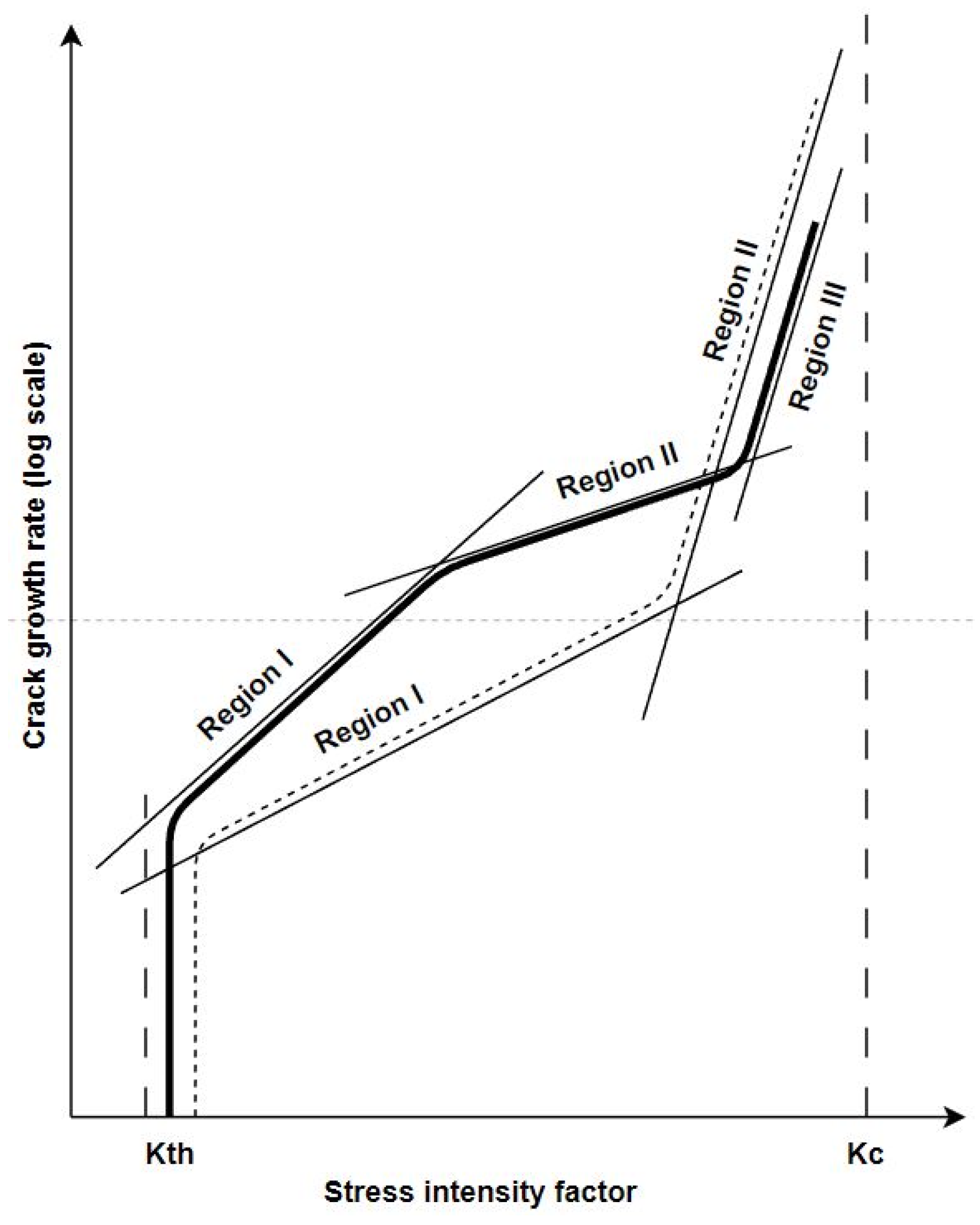
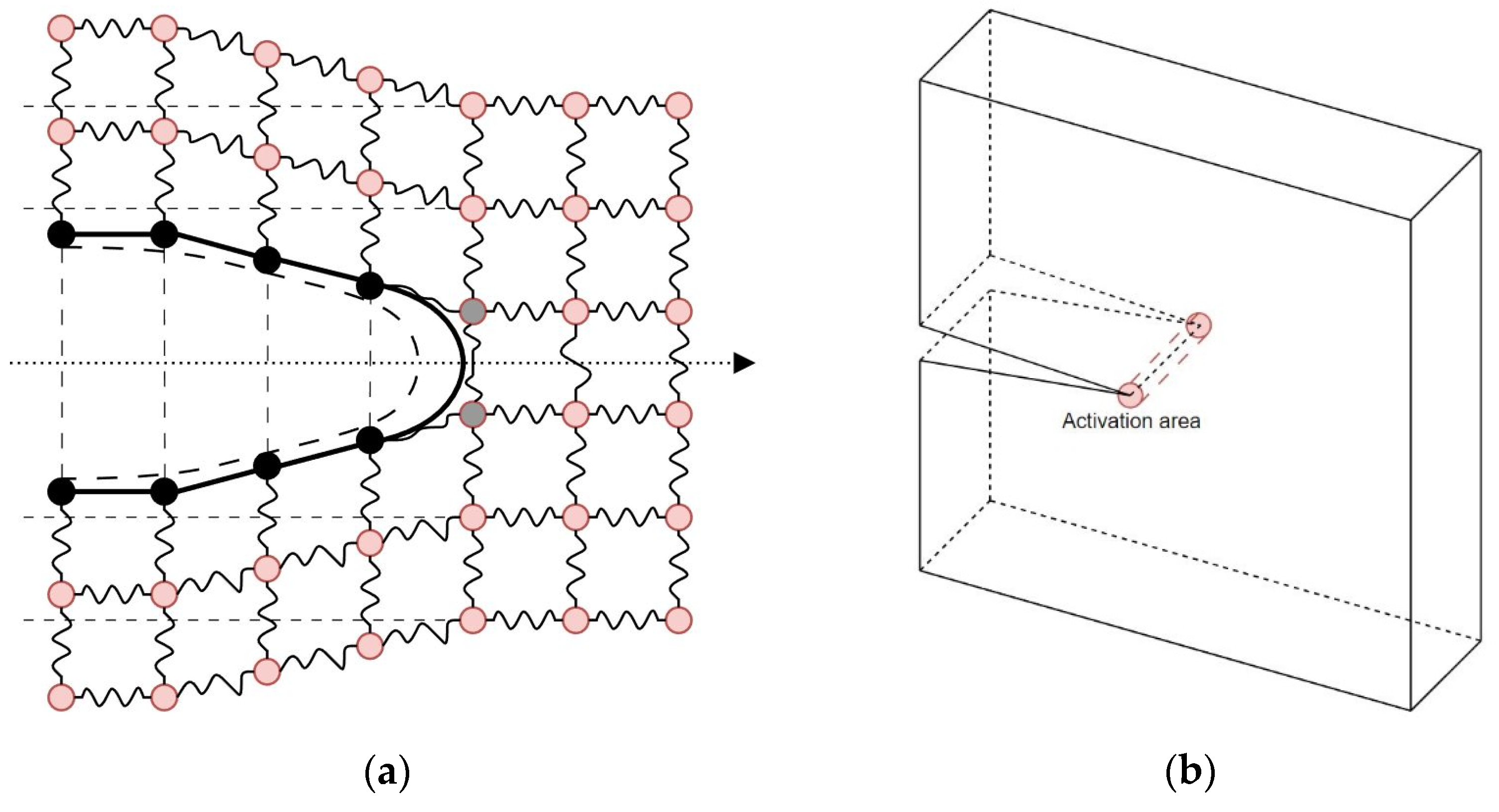
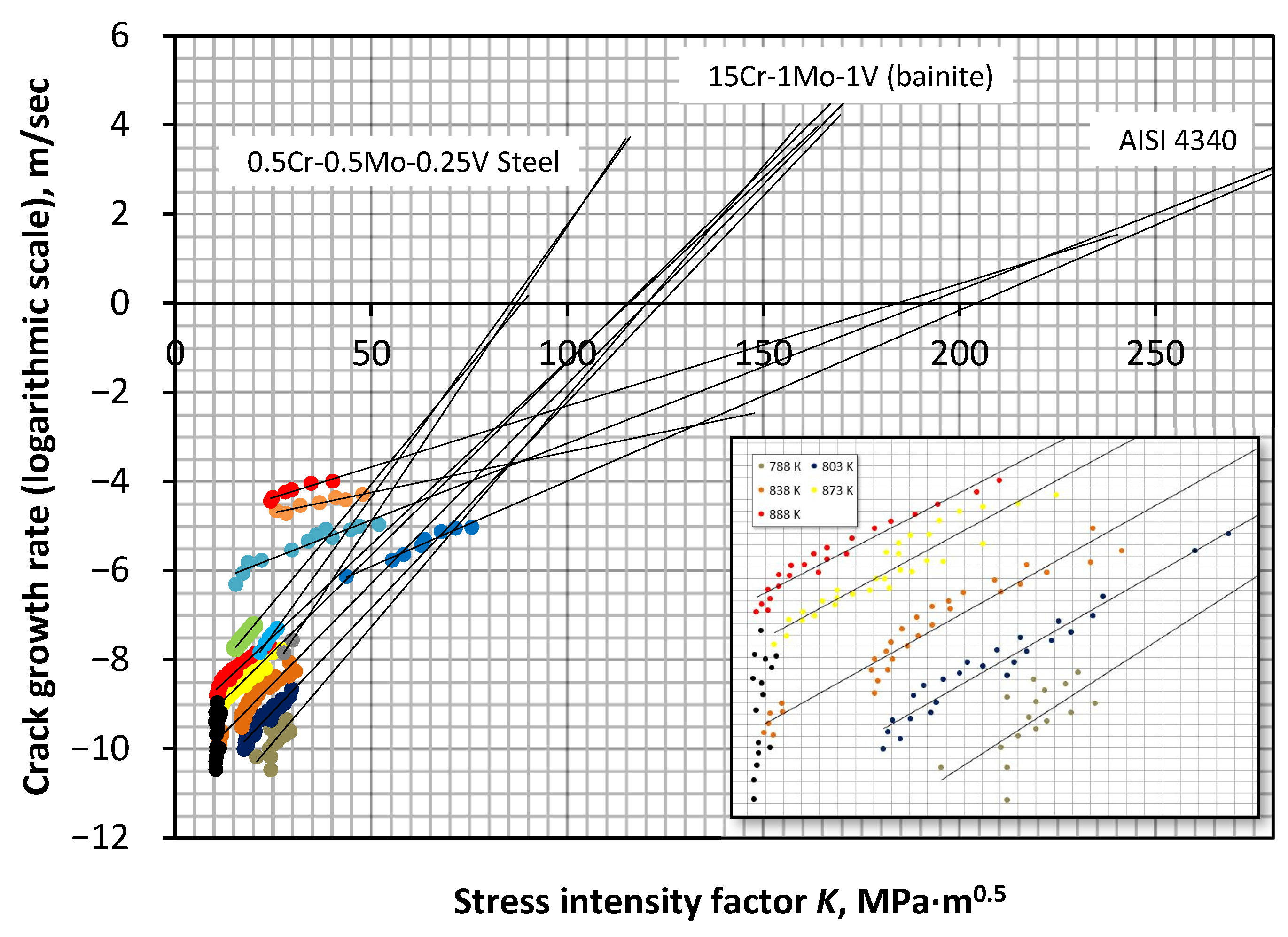
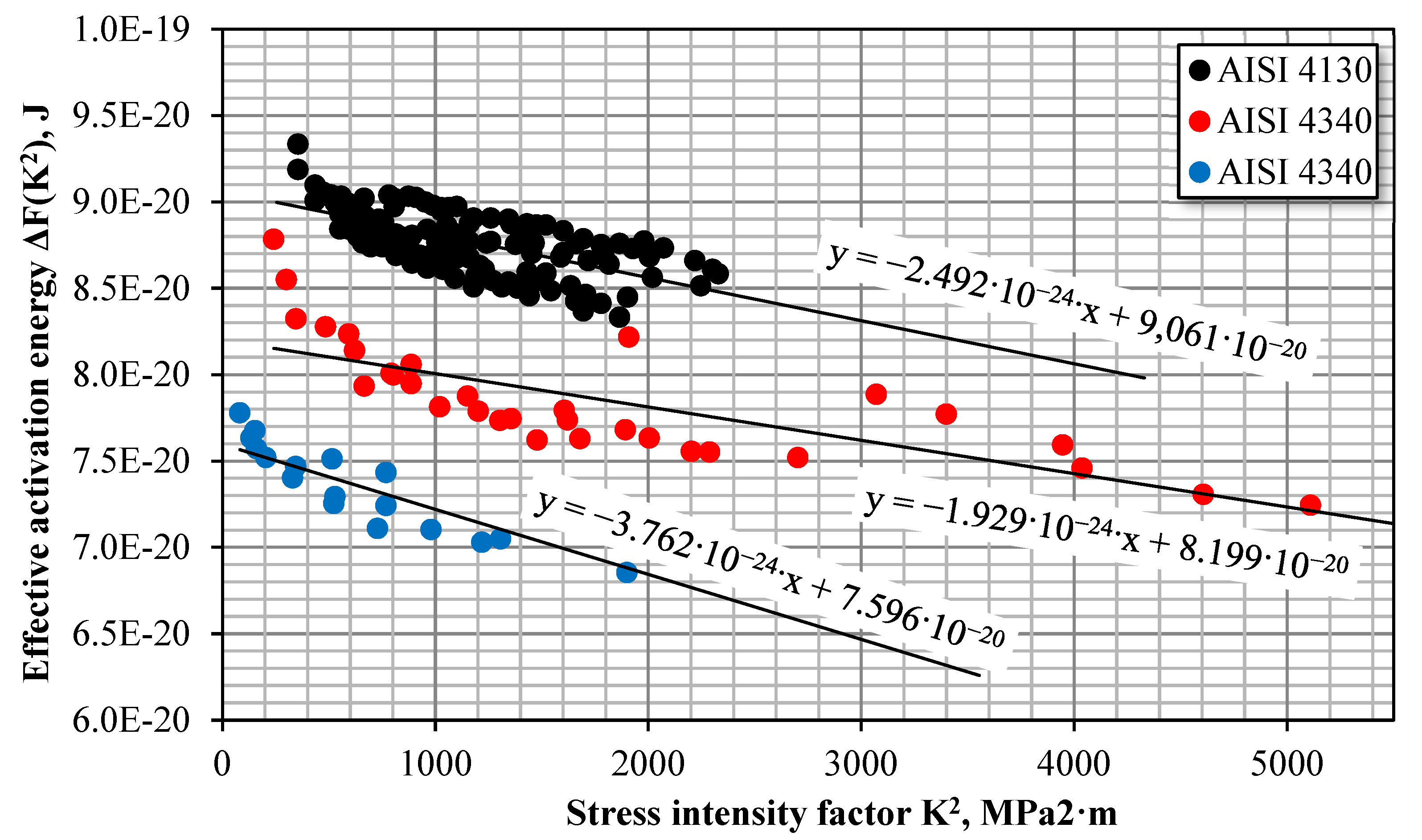
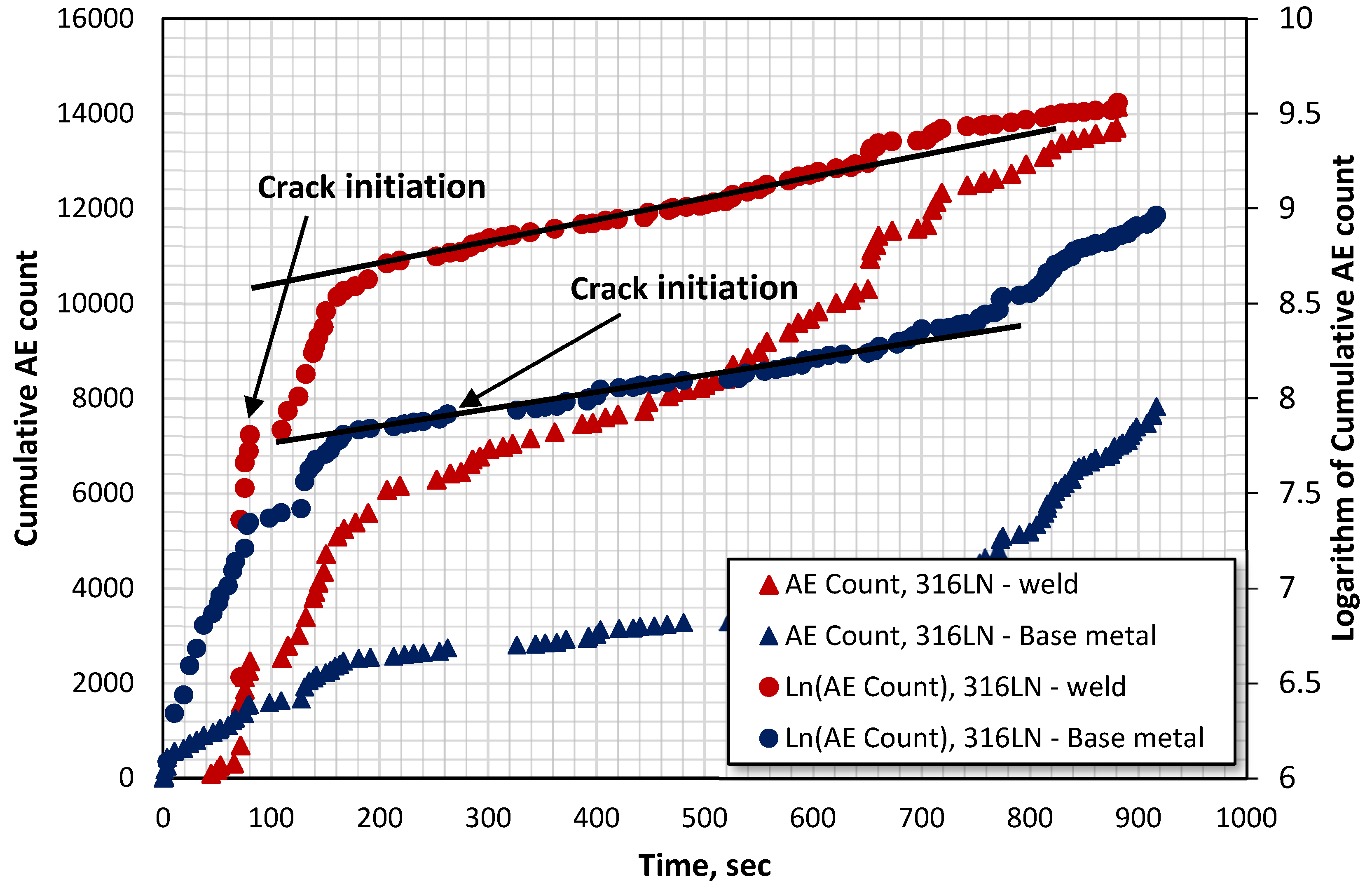
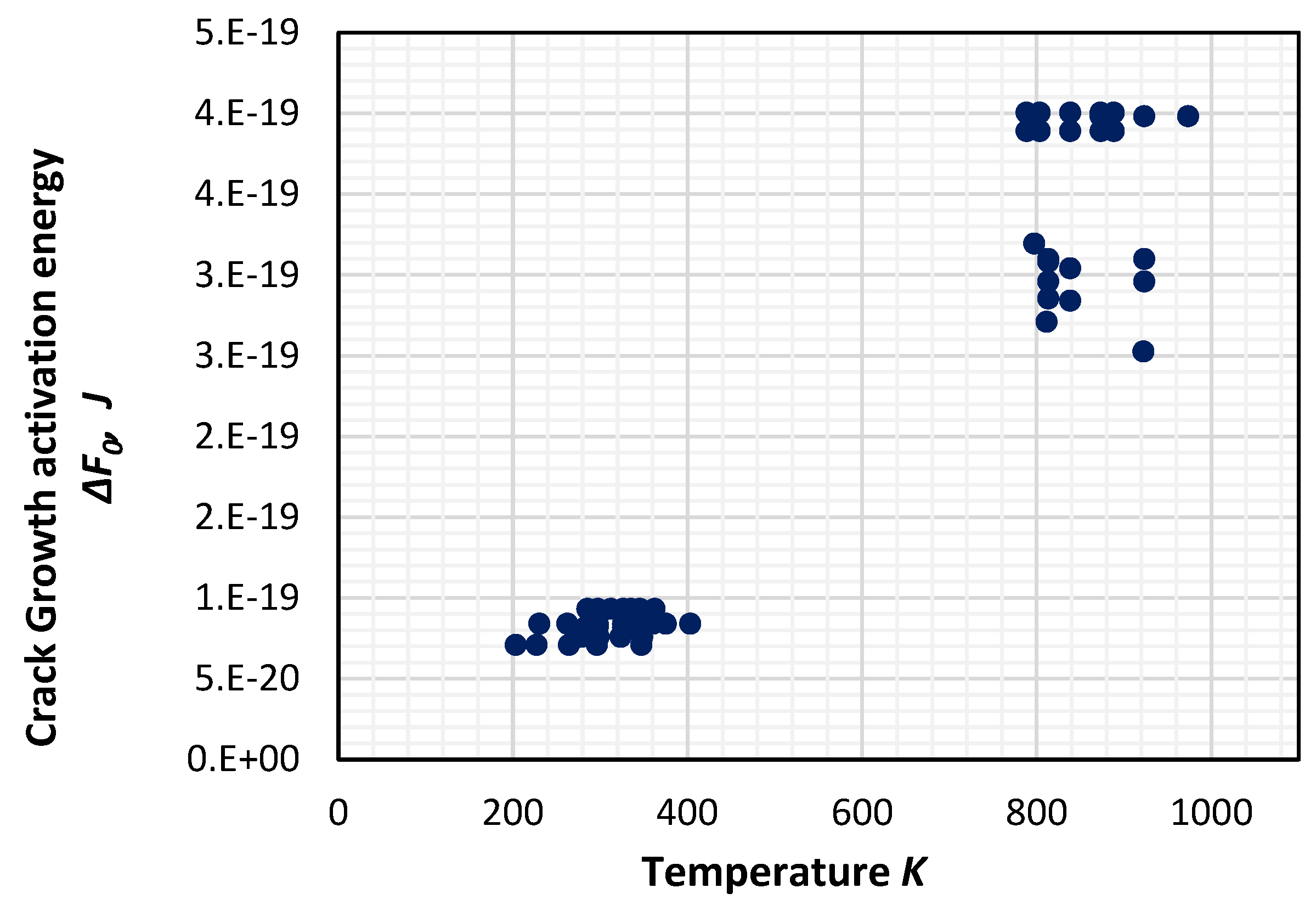


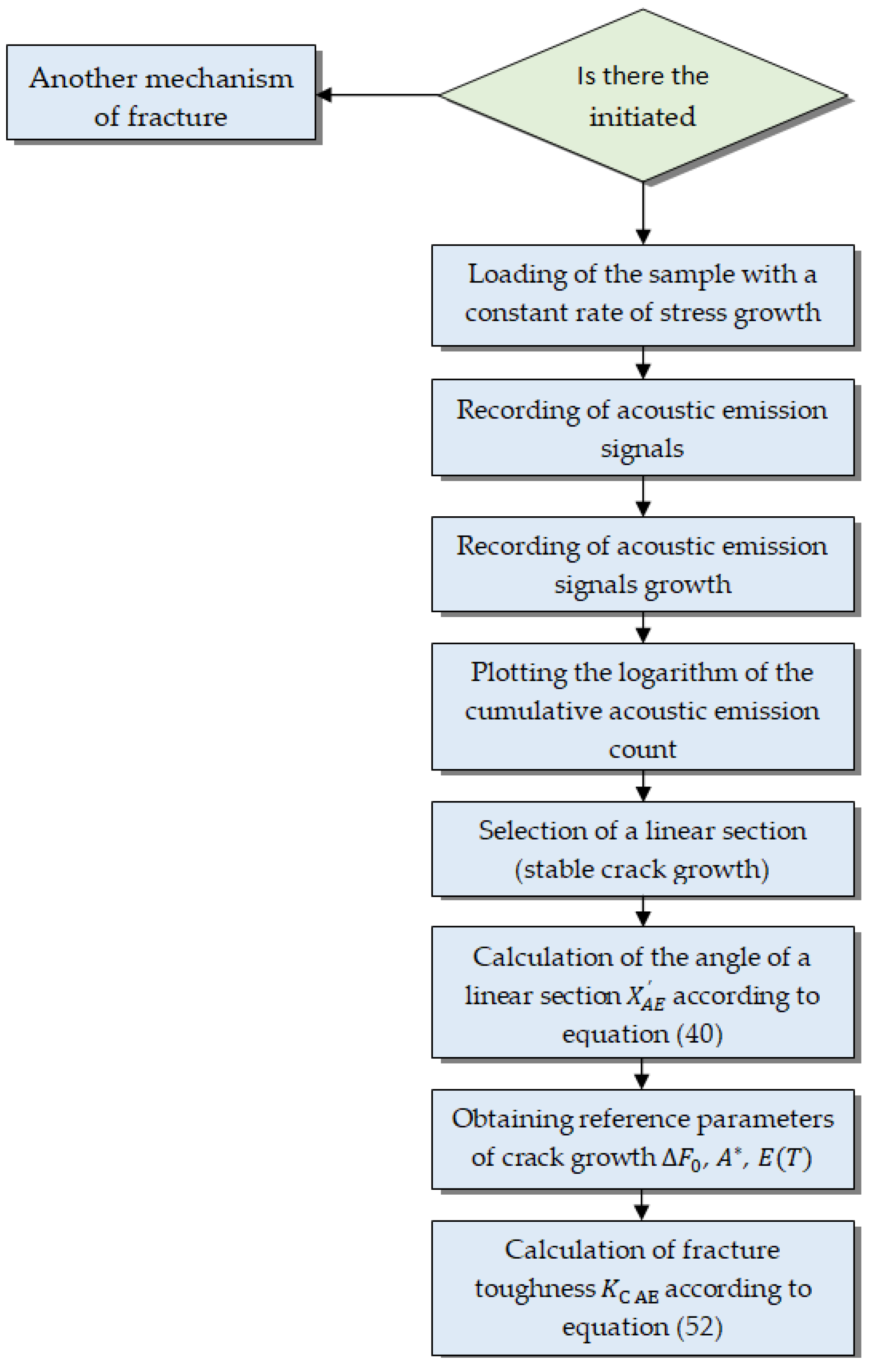
| Effective Activation Energy | Activation Area Function | Parameter on the Graph | Sources |
|---|---|---|---|
| The angle of the curve on the graph equal to | [33,34] | ||
| The angle of the curve (power law) on the graph equal to | [41,49] | ||
| The angle of the curve on the graph equal to | [37,47,48,50] |
| Material | Environment | ||||||||
|---|---|---|---|---|---|---|---|---|---|
| 15Cr-1Mo-1V (ferrite and carbides) [69] | Air | 2.43 | 214 | 1758 | 4.42 | 7.06 | 788–888 | 4.01 | |
| 15Cr-1Mo-1V (bainite) [69] | Air | 4.15 | 214 | 1758 | 7.53 | 12.05 | 788–888 | 3.89 | |
| AISI 4130 [70] | Distilled water | 0.4 | 205 | 1689 | 0.79 | 1.26 | 285–362 | 0.93 | |
| AISI 4130 [70] | Gaseous hydrogen | 0.64 | 205 | 1689 | 1.26 | 2.01 | 230–403 | 0.84 | |
| AISI 4340 [71] | Distilled water | 0.19 | 205 | 1700 | 0.38 | 0.6 | 283–348 | 0.82 | |
| AISI 4340 [72] | Distilled water | 0.38 | 205 | 1700 | 0.74 | 1.18 | 278–348 | 0.76 | |
| Ni-22.9Al-0.5Hf-0.24B Alloy [73] | Air | 16.03 | 168 | 1668 | 21.95 | 35.11 | 773–1033 | 2.88 | |
| Ti-5Al-2.5Sn [74] | Gaseous hydrogen | 0.08 | 110.3 | 1863 | 0.09 | 0.14 | 203–347 | 0.71 | |
| 0.5Cr-0.5Mo-0.25V Steel [75] | Air | 5.81 | 190 | 1693 | 10.68 | 17.08 | 797–838 | 3.11 | |
| 6.22 | |||||||||
| 7.92 | |||||||||
| 0.5Cr-0.5Mo-0.25V Steel [75] | Air | 3.77 | 190 | 1693 | 7.53 | 12.04 | 813–838 | 2.85 | |
| 5.64 | |||||||||
| Inconel 718 [76] | Air | 0.41 | 208 | 1298 | 0.61 | 0.98 | 811–922 | 1.94 | |
| 0.36 | |||||||||
| Inconel X-750 [77] | Air | 0.41 | 213.7 | 1410 | 0.69 | 1.1 | 813–923 | 3.1 | |
| Incoloy 800 [77] | Air | 0.52 | 196.5 | 1371 | 0.8 | 1.27 | 196.5 | 2.96 | |
| AISI 304 [78] | Air | 4.31 | 193 | 1723 | 6.83 | 10.93 | 193 | 3.98 |
Disclaimer/Publisher’s Note: The statements, opinions and data contained in all publications are solely those of the individual author(s) and contributor(s) and not of MDPI and/or the editor(s). MDPI and/or the editor(s) disclaim responsibility for any injury to people or property resulting from any ideas, methods, instructions or products referred to in the content. |
© 2023 by the authors. Licensee MDPI, Basel, Switzerland. This article is an open access article distributed under the terms and conditions of the Creative Commons Attribution (CC BY) license (https://creativecommons.org/licenses/by/4.0/).
Share and Cite
Perveitalov, O.G.; Nosov, V.V.; Schipachev, A.M.; Alekhin, A.I. Thermally Activated Crack Growth and Fracture Toughness Evaluation of Pipeline Steels Using Acoustic Emission. Metals 2023, 13, 1272. https://doi.org/10.3390/met13071272
Perveitalov OG, Nosov VV, Schipachev AM, Alekhin AI. Thermally Activated Crack Growth and Fracture Toughness Evaluation of Pipeline Steels Using Acoustic Emission. Metals. 2023; 13(7):1272. https://doi.org/10.3390/met13071272
Chicago/Turabian StylePerveitalov, Oleg G., Viktor V. Nosov, Andrey M. Schipachev, and Alexey I. Alekhin. 2023. "Thermally Activated Crack Growth and Fracture Toughness Evaluation of Pipeline Steels Using Acoustic Emission" Metals 13, no. 7: 1272. https://doi.org/10.3390/met13071272
APA StylePerveitalov, O. G., Nosov, V. V., Schipachev, A. M., & Alekhin, A. I. (2023). Thermally Activated Crack Growth and Fracture Toughness Evaluation of Pipeline Steels Using Acoustic Emission. Metals, 13(7), 1272. https://doi.org/10.3390/met13071272






